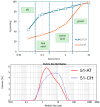Effect of Rice Husk Addition on the Hygrothermal, Mechanical, and Acoustic Properties of Lightened Adobe Bricks
- PMID: 40731574
- PMCID: PMC12297958
- DOI: 10.3390/ma18143364
Effect of Rice Husk Addition on the Hygrothermal, Mechanical, and Acoustic Properties of Lightened Adobe Bricks
Abstract
In the context of efforts to reduce greenhouse gas emissions in the building sector, the reintegration of traditional earthen construction into modern architectural and renovation practices offers a sustainable alternative. To address the mechanical and water-resistance limitations of adobe bricks, the use of agricultural waste-such as rice husk-is increasingly being explored. This experimental study evaluates the effects of rice husk addition on the mechanical, hygrothermal, and acoustic properties of adobe bricks. Two soil types-one siliceous and one calcareous-were combined with 1, 2, and 3 wt% rice husk to produce bio-based earthen bricks. The influence of rice husk was found to depend strongly on the soils' mineralogical and granulometric characteristics. The most significant improvements were in hygrothermal performance: at 3 wt%, thermal conductivity was reduced by up to 35% for calcareous soil and 20% for siliceous soil, indicating enhanced insulation. Specific heat capacity also increased with husk content, suggesting better thermal inertia. The moisture buffering capacity, already high in raw soils, is further improved due to increased surface porosity. Mechanically, rice husk incorporation had mixed effects: a modest increase in compressive strength was observed in siliceous soil at 1 wt%, while calcareous soil showed slight improvement at 3 wt%. Acoustic performance remained low across all samples, with minimal gains attributed to limited macro-porosity. These findings highlight the importance of soil composition in optimizing rice husk dosage and suggest promising potential for rice husk-stabilized adobe bricks, especially in thermally demanding environments.
Keywords: acoustics; adobe; compressive strength; lightened earth; moisture buffer value; rice husk; thermal performance.
Conflict of interest statement
The authors declare no conflicts of interest.
Figures


















References
-
- Doat P., Hays A., Houben H., Matuk S., Vitoux F. Construire en Terre. Parenthèses; Paris, France: 1979.
-
- Marsh A.T.M., Kulshreshtha Y. The state of earthen housing worldwide: How development affects attitudes and adoption. Build. Res. Inf. 2022;50:485–501. doi: 10.1080/09613218.2021.1953369. - DOI
-
- Ness D.A., Xing K. Toward a Resource-Efficient Built Environment: A Literature Review and Conceptual Model. J. Ind. Ecol. 2017;21:572–592. doi: 10.1111/jiec.12586. - DOI
-
- Danso H., Martinson D.B., Ali M., Williams J.B. Physical, mechanical and durability properties of soil building blocks reinforced with natural fibres. Constr. Build. Mater. 2015;101:797–809. doi: 10.1016/j.conbuildmat.2015.10.069. - DOI
-
- Van Damme H., Houben H. Earth concrete. Stabilization revisited. Cem. Concr. Res. 2018;114:90–102. doi: 10.1016/j.cemconres.2017.02.035. - DOI
LinkOut - more resources
Full Text Sources

